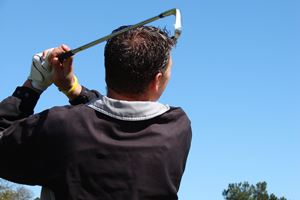The great Jack Nicklaus once said, “The game is meant to be fun.” But the game of golf can quickly become a lot less fun when back pain is involved. Not only does it hurt when you swing a club (sometimes a lot), but your biomechanics also change as your body naturally adapts its movements in an attempt to minimize the discomfort. This means that your swing will become less consistent and probably less effective—reducing power and accuracy. Plus, trying to “play through the pain” may mean that you’re setting yourself up for a more serious injury and a longer recovery time down the road.
And don’t think this happens only to amateurs. One survey amongst pro golfers showed that 77% of them have experienced back pain. Dr. Chris Garner, DC, who treats lots of pro golfers with chiropractic healthcare in Myrtle Beach, says that the combination of motions—forward, side-to-side and twisting—creates a shearing force on the vertebrae of the spine.
If your body is not in good shape or warmed up properly, this shearing force can knock your spine out of alignment. If pro golfers on the PGA Tour can experience back pain, even with their superb form, the average golfer remains at far greater risk with their less-than-pro golf swing mechanics.
There are a few ways to protect your back while improving your golf swing. Perhaps one of the best ways is to take golf lessons. The Mayo Clinic recommends golf lessons as one of the best ways of reducing golf injuries. And don’t let pride get in your way. Jack Nicklaus had some words of wisdom on this point, too. “Don’t be too proud to take lessons. I’m not.” With professional golf lessons, you can improve your golf swing mechanics and reduce the shearing force on your spine.
Performing stretching exercises is another method for improving your body’s ability to handle the shearing forces without injury. Start slowly, gradually increasing your range of motion, without making sharp, jerking movements. Stretching well before your game (or even before practicing your golf swing) can help you avoid injury and also improve the fluidity of your swing. Stretching will also help to warm up your muscles before playing. But warming up doesn’t stop with stretching. The Mayo Clinic recommends adding a brisk walk or jumping jacks before practicing your swing or playing a round. Remember, when you first start swinging your clubs, begin small and slowly increase the range of motion.
Off the golf course, you can help prepare your body for better performance. Anyone who watches professional golf on television knows that you don’t need bulging muscles to drive a ball 300 yards down the fairway. That said, greater strength, flexibility and endurance can certainly help your swing. It can also help protect your body from injury since you’re not straining your body to achieve the desired distance. Taking up cycling or swimming laps can also help increase your stamina to prevent injury from attempting to play through fatigue.
Golf places serious demands on your entire musculoskeletal system, and chiropractic care can be an important part of your game. Regular adjustments and consultation with your chiropractor help maintain top spinal health, which is the foundation for good swing mechanics. Tiger Woods once said, “I’ve been going to Chiropractors for as long as I can remember. It’s as important to my training as practicing my swing.”

